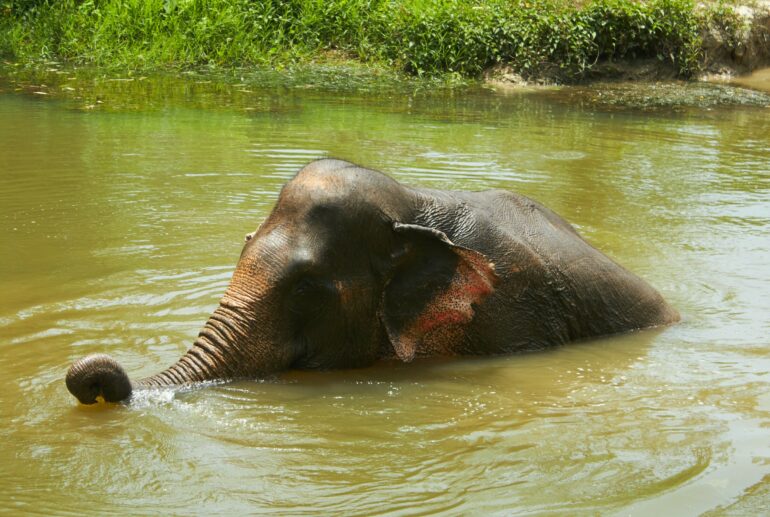Elephant tourism in Thailand is a big draw: but if you want to see the magnificent creatures, it’s important to make sure you’re doing it ethically and sustainably, in a way that’s best for them.
Could there be a more evocative, impressive, magnificent symbol of Thailand than the elephant?
Elephants are awesome in the literal sense of the word, and for decades an elephant ride was at the top of every traveller’s Thailand bucket list. For those who grew up taking donkey rides on the beach, it wasn’t something you questioned. We ride horses and think nothing of it. Why should riding an elephant be any different?
Today, we know better. Even in the past ten years, the public understanding of what is and isn’t ethical has evolved in a big way. Now, we know that elephants who are trained to give rides or perform tricks can only do so because they’ve been through a cruel and brutal process called “crushing”, or phajaan. The feats they can perform — balancing acts, painting pictures, playing instruments — might be amazing to watch, but they’re unnatural, and the process used to achieve them is cruel.
We’ve long known that such circus-like tricks aren’t OK, but in recent years the thinking about other elephant activities has been changing, too.
Today, most of the travel industry agrees that any contact between elephants and humans is problematic, because all contact depends on the elephant having been trained to ignore its natural instincts. This includes activities that until recently were considered “responsible” like bathing elephants or riding them bareback.
The only really ethical way to see elephants is in the wild. Sadly, it’s not that simple. So, what’s the next best thing?
Why is responsible elephant tourism so complicated?
In an ideal world, elephants would be allowed to roam free in their natural habitat. Nowadays, however, there simply isn’t enough of that habitat left. Even if there were enough ‘wild’ for them to inhabit, elephants who’ve spent their lives in captivity just aren’t equipped to return to it.
Another big problem is money. The costs associated with caring for an elephant are huge. They include not just space, food, shelter and veterinary care, but also a living wage for those who look after them. Charities cover a small proportion of these costs, but tourism covers the rest. Covid-19, with its associated drop in tourist numbers, has made the situation that much harder.
Without money from tourism, it’s probable that many mahouts (elephant handlers) and their animals would be forced to turn to illegal logging or begging on the streets to survive. Conservation projects that previously relied on money from elephant tourism would begin to fail, and we could see further deforestation and ecological damage as a result.
In short, responsible elephant tourism represents a whole, multi-faceted economy – and isn’t as simple as just avoiding a few unethical elephant camps.
What should you do?
With all of this in mind, the consensus among responsible tourism providers (like us) is that, for the time being, elephant tourism is necessary and good — but that it must be done with the least possible impact on the wellbeing of the elephants.
It’s important to be discerning. Not every elephant camp that calls itself a “sanctuary” is necessarily doing everything right. These are the guidelines we follow when selecting elephant experiences to recommend:
- Contact between humans and elephants should be kept to a minimum, and where possible elephants should be left to behave like elephants. If there is any sort of contact (like feeding), there should be a barrier in place to keep you safe, as well as the elephants
- Feeding and touching rescued elephants who are already accustomed to human contact is OK, but bathing or riding them is not (as mentioned, some wildlife groups maintain that any contact with humans is a no-no)
- Sanctuaries should not be breeding elephants in captivity, unless the aim is to return the babies to the wild
- Sanctuaries should only be caring for elephants which cannot be rehabilitated and returned to the wild
- Elephants should be left to roam free in large enclosures, never hobbled with chains
One of our favourite responsible elephant sanctuaries right now is Elephant Hills in Khao Sok. This sanctuary is a leader in ethical elephant tourism, combining a luxury safari-style tent camp and stunning lakeside scenery with the opportunity to meet elephants in as close to their natural condition as possible. There are also plenty of opportunities for exploring the surrounding jungle on foot or by canoe.
Our Wild Thailand Family Adventure itinerary was designed with families in mind, but it’d make a fantastic trip for any active wildlife-lover. We can also design any trip to include a visit to the elephants: just get in touch with us to begin planning.



